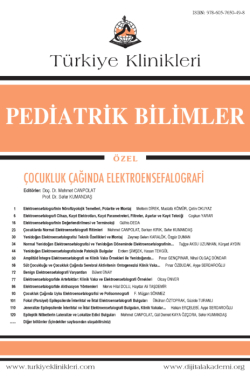Normal Neonatal Electroencephalography and Maturation of Electroencephalography During Neonatal Period
Tuğçe AKSU UZUNHANa, Kürşad AYDINb
aÇocuk Nörolojisi Kliniği, Sağlık Bilimleri Üniversitesi Okmeydanı Eğitim ve Araştırma Hastanesi, İstanbul, TÜRKİYE
bÇocuk Nörolojisi BD, İstanbul Medipol Üniversitesi Tıp Fakültesi, İstanbul, TÜRKİYE
Aksu Uzunhan T, Aydın K. Normal yenidoğan elektroensefalografisi ve yenidoğan döneminde elektroensefalografinin matürasyonu. Canpolat M, Kumandaş S, editörler. Çocukluk Çağında Elektroensefalografi. 1. Baskı. Ankara: Türkiye Klinikleri; 2019. p.34-43.
ABSTRACT
Despite evolving technologies, electroencephalography (EEG) remains a powerful tool for neurological diagnosis and prognosis in both preterm and term neonates. Neonatal EEG is different from children and adult’s EEG technically and also because it changes week by week as a result of brain maturation and growth. An EEG finding normal in a developmental stage may be abnormal in a different developmental stage owing to these rapid changes of brain growth. So it is important to know normal patterns of neonatal EEG in different conceptional weeks and behavioral states (sleep, awakeness). In this section, technical and qualitative features of normal neonatal EEG will be mentioned, normal graphoelements and maturational changes on the EEG background of neonates going through preterm to term age will be described.
Keywords: Infant, newborn; electroencephalography
Kaynak Göster
Referanslar
- St. Louis E, Frey L. Electroencephalography (EEG): An Introductory Text and Atlas of Normal and Abnormal Findings in Adults, Children and Infants. Chicago, IL: American Epilepsy Society; 2016. p.95.
- Tekgul H, Bourgeois BF, Gauvreau K, Bergin AM. Electroencephalography in neonatal seizures: comparison of a reduced and a full 10/20 montage. Pediatr Neurol. 2005;32(3): 155-61. [Crossref] [PubMed]
- Kuratani J, Pearl PL, Sullivan L, Riel-Romero RM, Cheek J, Stecker M, et al. American Clinical Neurophysiology Society Guideline 5: minimum technical standards for pediatric electroencephalography. J Clin Neurophysiol. 2016;33(4):320-3. [Crossref] [PubMed]
- Tsuchida TN, Wusthoff CJ, Shellhaas RA, Abend NS, Hahn CD, Sullivan JE, et al. American Clinical Neurophysiology Society standardized EEG terminology and categorization for the description of continuous EEG monitoring in neonates: report of the American Clinical Neurophysiology Society critical care monitoring committee. J Clin Neurophysiol. 2013;30(2):161-73. [Crossref] [PubMed]
- Hahn J. Neonatal and pediatric electroencephalography. In: Aminoff M, ed. Aminoff's Electrodiagnosis in Clinical Neurology. 6th ed. China: Saunders; 2012. p.85-128. [Crossref]
- Hayakawa M, Okumura A, Hayakawa F, Watanabe K, Ohshiro M, Kato Y, et al. Background electroencephalographic (EEG) activities of very preterm infants born at less than 27 weeks gestation: a study on the degree of continuity. Arch Dis Child Fetal Neonatal Ed. 2001;84(3):F163-7. [Crossref] [PubMed] [PMC]
- Hahn JS, Monyer H, Tharp BR. Interburst interval measurements in the EEGs of premature infants with normal neurological outcome. Electroencephalogr Clin Neurophysiol. 1989; 73(5):410-8. [Crossref] [PubMed]
- Mizrahi EM, Hrachovy RA. Atlas of Neonatal Electroencephalography. 4th ed. New York: Demosmedical; 2016. p.336. [Crossref]
- Scher MS, Johnson MW, Holditch-Davis D. Cyclicity of neonatal sleep behaviors at 25 to 30 weeks' postconceptional age. Pediatr Res. 2005;57(6):879-82. [Crossref] [PubMed]
- Levin K, Luders H. Comprehensive Clinical Neurophysiology. 1st ed. Philadelphia: Saunders; 2000. p.627.
- Clancy RR, Dicker L, Cho S, Cook N, Nicolsın SC, Wernovsky G, et al. Agreement between long-term neonatal background classification by conventional and amplitude-integrated EEG. J Clin Neurophysiol. 2011;28(1):1-9. [Crossref] [PubMed]
- Volpe JJ. Neurology of the Newborn. 5th ed. Philadelphia: Saunders, Elsevier; 2008. p.1094.
- Clancy RR. Electroencephalography in the premature and full-term infant. In: Polin RA, Fox WW, eds. Fetal and Neonatal Physiology. 3rd ed. Vol 2-2. Saunders; 2003. p.1726-45. [Crossref]
- Alix JJP, Ponnusamy A, Pilling E, Hart AR. An introduction to neonatal EEG. Paediatr Child Health (Oxford). 2017;27(3):135-42. [Crossref]

